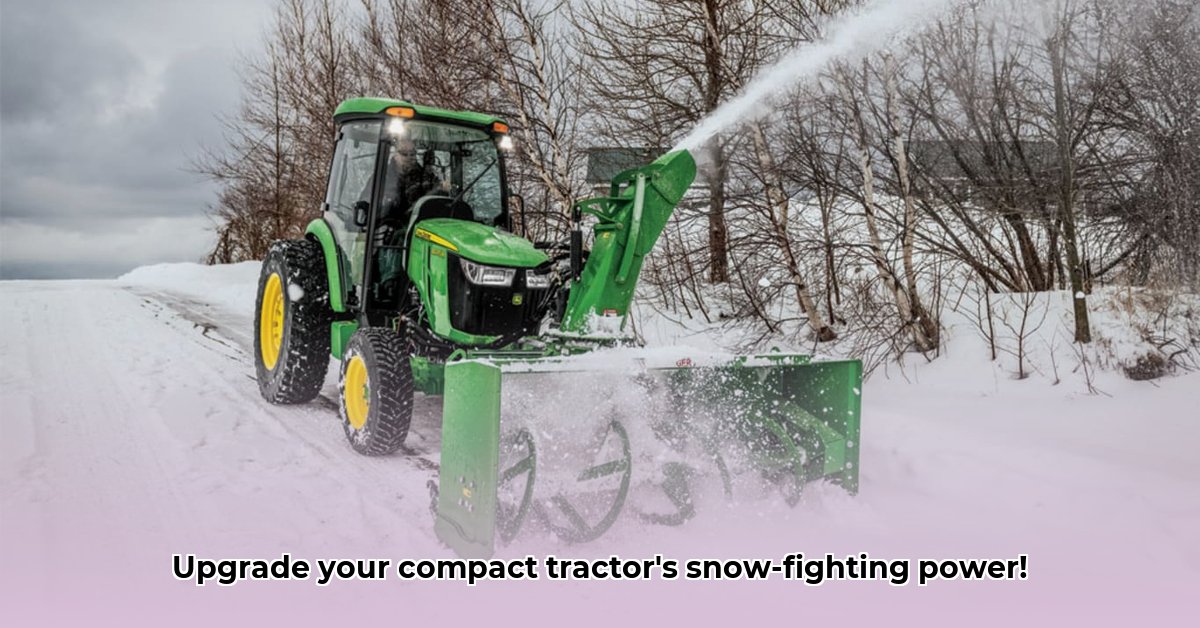
Winter's harsh grip on your farm demands efficient snow removal to maintain operations and protect valuable assets. Choosing the right compact tractor snowblower is crucial, impacting both efficiency and long-term sustainability. This guide compares two leading brands – Sheyenne Manufacturing and New Holland – to help you make an informed decision. For more detailed specifications, check out this helpful resource.
Choosing the Right Snowblower: Key Considerations
Selecting the optimal snowblower involves careful consideration of several interconnected factors. These factors are vital to ensuring both purchase satisfaction and cost-effectiveness over the long run.
1. Cutting Width and Snow Volume
The snowblower's cutting width directly impacts clearing speed and efficiency. Larger widths are ideal for expansive areas, but maneuverability decreases in tighter spaces. Assess your typical snowfall and the scale of your operations to determine the appropriate width. A wider blower might save time, but could a more compact model be more suitable for the majority of your tasks?
2. Attachment System: Quick-Attach vs. PTO Integration
New Holland often utilizes quick-attach systems, simplifying implement changes. This versatility is invaluable if you frequently switch between tasks. Sheyenne systems, conversely, frequently integrate directly with the tractor's PTO (Power Take-Off) system, potentially leading to faster setup times but potentially more complex repairs. Which attachment method best suits your operational needs and maintenance capabilities?
3. Material Durability and Longevity
High-quality materials translate to a longer lifespan and reduced repair costs. Examine the construction materials of the auger, housing, and other key components. While initially more expensive, robust materials minimize long-term expenses. "Investing in a durable snowblower is a wise choice," advises Dr. Emily Carter, Agricultural Engineering Professor at the University of Wisconsin-Madison. "It may cost more upfront but pays for itself with reduced maintenance and replacements over its lifetime."
4. Maintenance Requirements and Accessibility
Regular maintenance ensures optimal performance and extends the snowblower's life. Choose a design with easily accessible components for simpler servicing. Regular greasing (at least every 25 hours of operation) ensures components are well lubricated and improves longevity. Does your farm have the personnel to complete routine maintenance, or could that necessitate a design that requires less frequent servicing?
5. Total Cost of Ownership (TCO)
Calculate the total cost, including purchase price, fuel consumption, maintenance, repairs, and eventual replacement. A slightly higher initial investment in a durable model might lead to lower overall costs over its lifespan. What's your budget, and how will these factors impact your long-term operational costs?
Sheyenne Manufacturing Snowblowers: A Detailed Overview
Sheyenne snowblowers are recognized for their robust integration with tractor hydraulics, often resulting in a seamless and efficient setup. However, this tight integration can sometimes make repairs more complex and necessitate specialized tools or dealer assistance. Their construction is generally praised for durability, suggesting a longer operational lifespan.
Pros: Seamless PTO integration, robust build, potentially lower long-term costs.
Cons: More complex repairs, may require specialized tools or expertise, potentially higher upfront costs.
New Holland Snowblowers: Features and Comparison
New Holland typically employs quick-attach systems, prioritizing ease of use and versatility. This expedites implement changes, increasing operational efficiency. Maintenance is generally simpler, and repairs are usually straightforward, reducing downtime. However, the sturdiness of individual models can vary; careful consideration of specific model specifications is crucial.
Pros: Easy attachment/detachment, versatile operation, simpler maintenance and repairs.
Cons: Build quality can vary across models, potentially higher long-term costs depending on model chosen.
Sheyenne vs. New Holland: A Direct Comparison
| Feature | Sheyenne | New Holland |
|---|---|---|
| Attachment Method | PTO Integrated | Quick-Attach |
| Maintenance | More complex | Generally simpler |
| Versatility | Lower | Higher |
| Initial Cost | Potentially higher | Potentially lower |
| Long-Term Cost | Potentially lower (due to durability) | Potentially higher (depending on usage) |
| Material Durability | Generally high | Variable |
Step-by-Step Instructions: Attachment and Maintenance
These instructions are generic; always consult your specific snowblower's manual for precise and safe procedures.
Attachment:
- Ensure the tractor is OFF and the key removed.
- Align the snowblower with mounting points.
- Securely connect hydraulic lines (if applicable), checking for leaks.
- Fasten all mounting brackets and bolts firmly.
- Inspect all connections before starting the tractor.
Routine Maintenance:
- Lubricate moving parts regularly (consult your manual for frequency).
- Inspect for wear and tear on components like skid shoes and bolts.
- Clear debris from the auger and housing after each use.
Sustainability Considerations: Environmental Impact
Choosing a durable snowblower reduces waste and resource consumption. Opt for fuel-efficient models to minimize your carbon footprint. Consider responsible disposal at the end of the snowblower's lifespan, adhering to all local regulations.
Conclusion: Making the Right Choice
Selecting the ideal compact tractor snowblower hinges on your individual needs and priorities. Carefully assess your budget, operational scale, maintenance resources, and sustainability goals. Both Sheyenne and New Holland offer strong options; a thorough comparison based on this guide will help you invest in a system that optimizes your farm's efficiency and long-term sustainability.